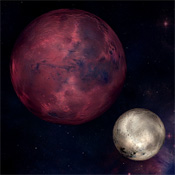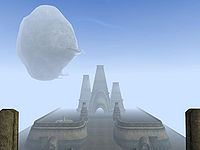Utilizador:Quill/Sandbox2
Índice
Planetary system
The model of the planetary system in the Imperial Orrery, the orrery itself, shows a number of celestial bodies, most orbiting the largest, glowing central sphere, which can be assumed to be Nirn, the heart of creation. The celestial bodies closest to Nirn are its two moons, Masser and Secunda. Further out, five large glowing spheres are all orbiting Nirn or Nirn's axis. In addition to these there are three smaller glowing spheres that do not orbit Nirn. Two of these orbit other planets, and the final sphere orbits one of those smaller spheres.
There is also a tiny sphere which is not glowing, and which might not be a celestial body, but rather a part of the machinery. If a planet, this sphere orbits Nirn's axis.
In total, eleven celestial bodies are represented in the orrery, twelve if you count the one that is not glowing. Apart from Nirn and its two moons there are eight or nine. As several Tamrielic pantheons consist of eight or nine deities (cfr the Nine Divines), and since planets often are linked to certain gods, it might be surmised that the eight planets orbiting Nirn are the plane(t)s of their respective deities. Known planets are Akatosh, Arkay and Julianos, all three representing the deity of the same name.[OOG 1]
Given the Orrery's age and Dwemer origin, it might not show any recent changes in the planetary system. For example, it has been suggested that Mannimarco's recent apotheosis resulted in a new celestial body, the Necromancer's Moon. It is not known whether the Necromancer's Moon is represented in this model.
Moons
Above Nirn there are two moons: Masser, also known as Jode or Mara's Tear; [1] and Secunda, also known as Jone or Stendarr's Sorrow.[1] Masser is the larger of the two, over twice as large by appearance. Since Secunda is sometimes seen to transit Masser, it is clear that Masser is indeed larger, not closer. [note 1] In Khajiiti legend, the motion of the moons constructs something called the "Lunar Lattice", which protects Mundus from the rest of Aetherius. [2] Khajiit are born in differing forms depending on the current phases of the moons. See Khajiiti Morphology for details.
Erro de citação: Existem elementos <ref> para um grupo chamado "OOG", mas não foi encontrado nenhum <references group="OOG"/> correspondente (ou falta um elemento de fecho </ref>)
Erro de citação: Existem elementos <ref> para um grupo chamado "note", mas não foi encontrado nenhum <references group="note"/> correspondente (ou falta um elemento de fecho </ref>)


